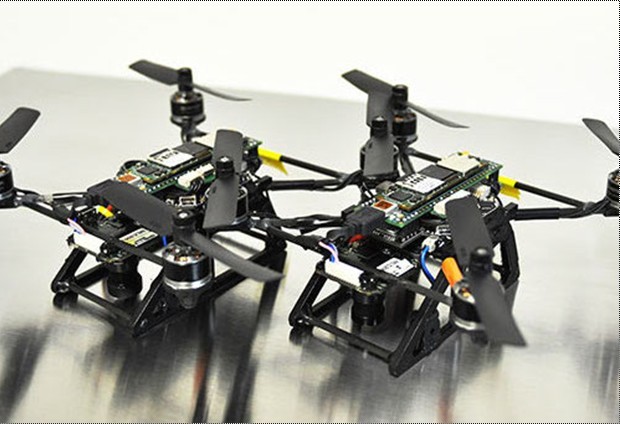We’ve been hearing a lot about robot swarms, biomimicry, and drones the size of insects, so it was only a matter of time before swarms of tiny flying robot drones hit the skies. Called micro air vehicles or micro aerial vehicles (MAVs), the latest development is an upcoming test of bee-inspired mechanical critters by the US Army at Fort Benning, Georgia.
The Army’s interest in high tech apiculture is coming from a need to increase a Soldier’s situational awareness of building interiors during urban operations, so don’t look for these biomimicry MAVs to sport tiny little bee stingers — yet. In any case, we’re more interested in the potential for clean tech applications.

The Army will test these bee-inspired micro air vehicles (image cropped, courtesy of US Army).
Biomimicry And Bee-Like Micro Air Vehicles
The last time we checked into the MAV scene, biomimicry was a hot topic. One example would be the “hummingbird” MAV developed by the Defense Advanced Projects Research Agency (DARPA, the same folks who invented the Internet), which is designed to look like an actual bird.
Another kind of approach is the butterfly inspired super-small MAV under development at Johns Hopkins University, Brown University’s fruit bat study, and the “dragonfly” MAV from the German company Festo. All three are engineered to mimic the flight characteristics of their respective namesakes, but they don’t come anywhere near resembling butterflies or dragonflies, or, for that matter, fruit bats.
The Army’s new biomimicry MAV falls into the latter category, but with a twist. The developers aren’t so much interested in the particular mechanics of their MAV’s flight. The real area of biomimicry focus is in the way these MAVs see.
Specifically, Army researchers were attracted by the wide field and high update rate that characterizes insect vision. The goal is to develop a small device that can fly into a building, map the interior in 3D, and provide feedback on movements within the building.
Also distinguishing this project from others is the autonomy of the MAV. The developers, which include Carnegie-Mellon University as well as the US Army Research Laboratory, are aiming for self-guided devices that can act autonomously as team members, rather than requiring hands-on direction.
Aside from the challenges of navigating stairways, doorways, and other structural complications, these MAV’s are going to have to function efficiently in other challenging environments such as caves and tunnels. Additional challenges include little or no light, no GPS assistance or other input, no advance scouting, and of course, being attacked.
Speaking Of Biomimicry…
The partnership with Carnegie-Mellon comes under the Army Research Lab’s Micro-Autonomous Systems Technology Collaborative Technology Alliance (MAST). If you check out MAST’s mission statement, you can see how the concept of robot-Soldier teaming fits into biomimicry on a macro scale, the end goal being mechanical combat multipliers that are able to act as a team with human beings and follow their commander’s intent.
Aside from the military application, we’re particularly interested in this new MAV for its potential use in farming and forestry, as a means of monitoring conditions and reducing the need for pesticides and herbicides.
If you’ve been reading about the ferocious feral hogs that have been bedeviling farmers in 39 states and counting, you can see how swarms of autonomous, highly maneuverable surveillance robots could also come in handy for crop protection.
We’re also expecting that low cost MAV’s and other autonomous robots will become useful in monitoring and inspecting remote or hard-to-access wind farms, solar installations, and other renewable energy infrastructure.
The above story is based on materials by CleanTechnica.
Note: Materials may be edited for content and length. For further information, please contact the source cited above
Copyright © 2024 International Society of Bionic Engineering All Rights Reserved
吉ICP备11002416号-1









